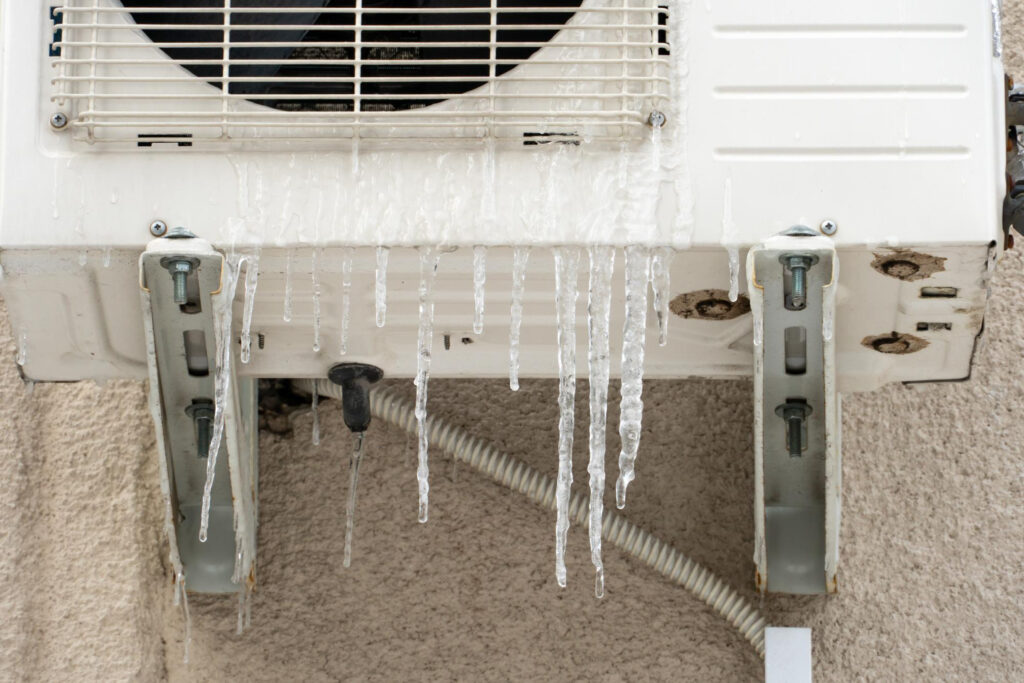When your ductless AC system suddenly stops cooling like it’s supposed to, one of the most common causes is a frozen evaporator coil. It can be frustrating, especially during Renton’s warm summer days when your home depends on consistent airflow and indoor comfort. A frozen coil doesn’t just slow down performance. It can cause your system to shut down entirely if it’s not addressed promptly.
Many homeowners aren’t sure why the freeze-up happens or what they can safely do about it. Often, it’s caused by conditions you can’t see right away, like low refrigerant, dirty filters, or weak airflow. If you can catch the signs early, you may be able to take safe steps before it causes bigger problems. This article explains what leads to a frozen evaporator coil and what to do next if it’s already happened inside your ductless AC system.
Understanding Why Your Ductless AC Evaporator Coil Freezes
The evaporator coil is a key part of how your ductless AC cools your home. As the system runs, refrigerant moves through the coil and absorbs heat from the air. The blower fan pushes cool air into your rooms while the heat exits through the outdoor unit. If something prevents the evaporator coil from working correctly, often due to low airflow or incorrect refrigerant levels, it can get too cold and freeze over instead of cooling the air.
Here are a few reasons that could cause your ductless system’s coil to freeze:
– Dirty or clogged air filters: When filters get packed with dust, airflow drops. Less warm air reaches the coil, which drops the temperature of the coil surface and allows ice to form.
– Blocked airflow around the indoor or outdoor unit: Furniture, curtains, or debris can get in the way of air movement and disrupt normal function.
– Low refrigerant: A slow leak in your system can reduce pressure and lower the temperature inside the coil. That’s enough to trigger freezing.
– Faulty fan or blower: The AC’s indoor unit depends on strong air circulation. If the fan motors or blades are worn out or damaged, airflow drops and the coil struggles to function.
– Mechanical failure or sensor issues: Even something small like a faulty sensor or wiring issue could interfere with coil operation and lead to freezing.
One example many homeowners face is discovering their AC blowing out warmer air than usual. After checking the indoor unit, they might notice water dripping and then see that layers of ice have built up around the evaporator coil. In this case, it’s likely a combination of a dirty filter and low refrigerant that caused poor airflow and ice buildup over time.
Understanding how the mechanics work and what causes freezing sets the stage to take the next steps with fixing the issue safely and efficiently. When it comes to any repairs involving refrigerant or mechanical parts, our professionals should step in to make sure the job gets done right. However, there are still safe actions you can take on your own before requesting a service visit.
Step-By-Step Guide to Fixing a Frozen Evaporator Coil
Once a frozen evaporator coil is discovered, the next course of action is to shut down the system completely. Letting it keep running will only lead to more damage and higher repair costs. Before anything else, power off the indoor unit and, if safe to do so, the outdoor unit as well.
From there, several steps can help reduce further damage and prepare the system for inspection:
1. Power off the unit – This stops the refrigerant cycle and mechanical operation, preventing strain on the parts.
2. Let the coil thaw – Open nearby windows or use fans to circulate room air. Never use hair dryers or heated objects, as direct heat can crack components.
3. Inspect and replace dirty filters – Look for filters that are brown, gray, or covered in visible buildup. Replace them with manufacturer-recommended filters.
4. Check for blocked vents or airflow restrictions – Make sure furniture or items like curtains aren’t blocking the indoor unit. Outside, ensure the condenser fan has clearance on all sides.
5. Visually inspect the drain pan and lines – As the coil thaws, melting ice may cause excess water. Check that the pan isn’t clogged.
6. Call our professionals for refrigerant-related issues – Refrigerant levels should never be adjusted without proper equipment. If the issue keeps coming back after replacing filters or improving airflow, it’s likely tied to a refrigerant leak or mechanical failure.
Keep in mind, once the coil thaws, the unit may look like it’s working fine. But if the root issue isn’t solved, the freeze-up will likely return. If you notice the coil icing over again within a few days, that’s a sign the problem is deeper than clogged filters or airflow. That’s when professional repair becomes necessary.
When to Call Our Professionals in Renton
There are a few signs that make it clear the frozen coil goes beyond a surface-level fix. If your ductless AC system runs for short periods before shutting off or never reaches the temperature set on the thermostat, the coil may be icing over behind the cover. If you hear loud hissing, clanking, or bubbling noises, refrigerant leaks or faulty fans may be at play.
Other red flags to note:
– Moisture or water staining on walls around the indoor unit
– Large buildup of ice across the back half of the unit or refrigerant lines
– Blinking error codes on the AC display panel or remote
Any of those may point to issues that require more than a filter swap or system reset. Our technicians use tools that measure refrigerant pressure, inspect the coils internally, and test airflow speed. These are things the average homeowner shouldn’t attempt. Fixing just the visible ice without solving the internal cause puts the AC at risk for overheating or compressor damage.
Preventative Maintenance Tips for Ductless Systems
Preventing a frozen evaporator coil starts with regular upkeep. Ductless AC systems need clear airflow, stable refrigerant pressure, and unobstructed components to function well, especially during Renton’s summertime heat. Establishing a routine maintenance schedule can reduce the chance of breakdowns that affect comfort and energy usage.
Here are a few tips to help prevent freezing coils in the future:
– Clean or change the filters every one to two months during cooling season
– Keep interior vents open and clear of furniture or fabric
– Trim plants or shrubs around the outdoor unit to protect airflow
– Watch for leaks, moisture, or anything unusual during normal use
– Schedule a seasonal inspection before the hottest months begin
The small cost of basic upkeep can help avoid much bigger repairs that usually happen when systems go unchecked for too long.
Why Fast Attention Matters for Frozen Coils
A frozen evaporator coil might seem like a small issue at first, especially when the unit starts working again after it thaws. But repeated freezing cycles can seriously wear down your ductless AC. Over time, it stresses the compressor and shortens the lifespan of the unit.
In some Renton homes, this issue comes up annually, usually in the hottest weeks of summer, because older systems don’t get tuned up, and small problems like weak refrigerant or clogged filters don’t get caught early. It’s not just about comfort. It’s about protecting the investment you’ve made in your home’s cooling setup. Letting a frozen coil go untreated usually leads to higher utility bills, uneven temperatures, and larger repairs down the line. Addressing the issue when it starts saves time, money, and stress over the long run.
If your ductless system continues to struggle with performance issues despite basic maintenance, Furnace Doctors is here to help restore comfort with expert support and timely solutions. Don’t let a minor freeze turn into major damage—address underlying system problems with dependable ductless AC repair in Rentonto protect your cooling investment. For a quick estimate or to book a service visit, please contact ustoday.



